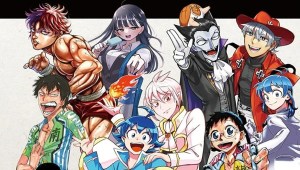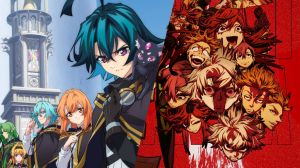Wonder Woman: Tempest Tossed makes its way into comic book stores this week, providing the Princess of Themyscira with an emotional and timely origin story. The graphic novel, which is the latest from DC’s line of young adult OGNs, opens on a sixteen-year-old Diana Prince, who feels awkward and ostracized on her home in Themyscira. Young Diana’s life is quickly changed forever, when her efforts to save a boat of refugees that washed up on Themyscira’s shore quickly goes awry. Unable to return to her home, Diana is now a refugee herself and is eventually brought over to the United States. There, Diana becomes a part of New York’s immigrant community, and comes into her own as a hero in the process.
Videos by ComicBook.com
Tempest Tossed is engrossing, entertaining, and incredibly emotional, and will make readers of all ages feel galvanized to improve the world around them. At the center of the graphic novel’s team are Laurie Halse Anderson, an author known for young adult titles such as Speak and the Seeds of America franchise, and Leila del Duca, a comic artist whose work includes Sleepless and Shutter. Anderson’s narrative and Del Duca’s art work together in perfect harmony, and make Tempest Tossed a must-read graphic novel for DC fans.
In celebration of Wonder Woman: Tempest Tossed‘s debut, we got to chat with Anderson and Del Duca about bringing their unique and relevant story to life. In the process, we talked about the story’s wonderful approach to costumes, what other DC characters they would like their version of Diana to meet, and so much more.

Wonder Woman
ComicBook.com: What was your relationship with Wonder Woman prior to working on this, given how iconic of a character she is?
Leila Del Duca: My relationship with Wonder Woman, at first, wasn’t too expansive. I think the first time I read a Wonder Woman graphic novel was in college, and it was really fun. I loved reading it. I think it was drawn by Terry Dodson. I don’t remember the rest of the team, but I was ecstatic about the artwork, and the character was really cool. And then, to see her in pop culture as this mighty, powerful woman was amazing. I also watched the movie. So my knowledge of the character isn’t actually more expansive than that. But I do think that I got a good sense of who she was as a character, and what she cared about.
Laurie Halse Anderson: I’m a little bit – and by a little bit I mean quite a bit – older than Leila, and I think everybody else on this team. When I was 10 years old, it was comic books, and the Wonder Woman television show with Lynda Carter playing Wonder Woman. I had a full-size Lynda Carter as Wonder Woman poster on my closet door. She was such a shining light in my life because my mother’s version of what kind of girl I was supposed to be was very different from who I wanted to be. I’m a big woman, and I wanted to be big and strong and powerful and make the world better. And that’s what Diana gave me. So to be able to have put my toe in the water of the ocean that is Wonder Woman was astounding.
Real World

What was your motivation for putting Diana in such a profound real-world context?
Anderson: I should look up the magazine I saw a horrible photograph in. This photograph drove the whole story for me. A couple of years ago, when there were just countless families fleeing war across the Mediterranean Sea on rubber rafts. The picture that I saw, which will never leave me, was of somebody picking up life preservers that had washed ashore, and they were holding up a life preserver that was the size that you would put on an infant. The people in that boat hadn’t made it. I just looked at that tiny life preserver, and I was really affected by it.
The instruction that I was given was “Wonder Woman has to be sixteen in this book. We’d like it to have some scenes in Themyscira, and then get her to the United States.” Most of my writing is of teenagers, so that was really my wheelhouse. But what I love about teenagers is their fierceness, their passion for making the world a better place to see it, whether it’s being an activist for the Black Lives Matter movement or climate change. They get to that age where their eyes open up and they’re like, “Wow, this place is a mess! Adults, you have really, really screwed up. We’ll tell you how to do it”. And I was trying to bring that vibe in young Diana.
Balance
The story has so much weight to it, but it still feels very accessible and almost family-friendly. I was curious about what it was like to find that balance, both with the narrative and with the art.
Del Duca: It was pretty easy to find a balance with the art. I mean, because Laurie’s scripts just really affected me. It spoke to me and inspired me a lot. I think that we have the same ideas about a lot of things. So it was easy to portray that stuff, artistically. My vision for art is always having a variety of people shown on the page, different body types, and all this stuff. And I think also I got the sense, from Laurie, that she cared about the same things. So it was easy to imbue the story with a lot of diverse cast and a diverse environment.
Costumes

I love the costumes in Tempest Tossed so much. Diana’s hero costume, in particular, was really great. What was the approach to that aspect of it?
Del Duca: Themyscira, I imagine it being beautiful. It’s a utopia, art is thriving, and the fashion is impeccable. So when I was designing clothing for Themyscira, I got to go crazy with inspiration from modern-day couture and ancient Greece. I kind of tried to blend those two together.
And then when it starts building the refugee experience, I imagined Diana not having any fashion sense, beyond what’s available to her. Like she gets her clothing for free from the refugee camp. And then when she goes to New York City, is it hand me downs or –?
Anderson: No, no, no. Steve went shopping for her and bought her a bunch of clothes.
Del Duca: Yes! Okay, cool. So it just doesn’t seem at the forefront of her mind to be a fashionista. I kind of went to my own fashion sense, of what I wore while growing up, and it was more plain. So I gave her a more plain wardrobe. And then she eventually gets that dress and that’s really cool and more feminine. That’s kind of where I’m coming from. Her economic footing, I wanted it to reflect in her clothing.
And then, in the end – I don’t know if anyone’s going to catch this – but the dress she wears at the very end of the book, I tried to give a similar “W” motif that she has in a lot of her other clothing throughout her other iterations. Because she has the accessories of her costume, but she never truly has the torso and pants of the costume. I want her to have that at the end of the book. It was a nice finale, I think.
Anderson: I love that. It was really important to me that she not be hyper-sexualized. How about if we write some books where the main character is female, and it’s not about her cleavage. And I really, really, really love those choices Leila made, and the way she did it. It’s like looking at photographs of your mom when she was a teenager. You can see like the hints of the woman she would become when you look backwards. I think the choices that [Leila] made, like that subtle “W”, if you think to sort of the comics and other graphic novels and the movies, you’re like, “Oh, I see how that would, in some weird time continuum that doesn’t exist, makes sense. It makes sense that, as an adult, she makes some other choices.”
Steve Trevor
I love how Tempest Tossed handles Steve Trevor. I found that very unexpected, in a really fun way. So what was the thought process of essentially splitting him into two characters?
Anderson: I wanted this to be a book about friendship. I didn’t want Diana to have a love interest. Her love interest is herself, you know? She’s growing and trying to figure herself out, and then she develops some good friendships in this. I was like “What are you doing with Steve Trevor?” And the thought just… ideas are magic, right? And so the writer gods, I was on their radar that day, and the idea popped in head. “No, it’s Steve and Trevor.” That made me very excited.
Crossovers

In a sense, it feels like each title in DC’s young adult line kind of exists in its own pocket universe. With that in mind — if you were to bring another DC character into the Tempest Tossed universe and have them cross over with your Diana, who would it be?
Anderson: What? You are blowing my mind right now. Holy crap!
Del Duca: I would love for her to come in contact with Madame Xanadu. Because Madame Xanadu has similar, but also very different morals than Diana. I just think that that dynamic would be very interesting, and I think they would have some sort of love-hate thing going on, but in a good way. Good tension.
Sequel
If you both have the opportunity to continue Diana’s story and do some sort of sequel to Tempest Tossed, do you have an idea of what shape that would take?
Anderson: Oh, there’s so much to explore, right? I have no idea where it would go, but give me the opportunity. I would love to do it. This was such an honor. When you think about all the generations of creators before us, and now in the films and stuff. There are some really, really talented, good-hearted people who’ve done this work. So it’s an honor to walk alongside them in our process. That’s super, super cool. We all need more superheroes in the world these days, so I’d love to do it again.
Del Duca: Yeah, I would love to see more Diana. Laurie wrote a more realistic version of Diana, and I would love to see more of that in comics.
***
Wonder Woman: Tempest Tossed is available now.
This interview has been lightly edited for length and clarity.








